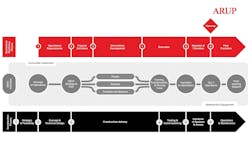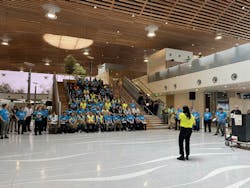Five Things You'll Learn from this Article
- Implementing ORAT early in the project lifecycle helps identify and resolve issues before construction completion, saving time and costs.
- Proactive ORAT strategies foster stakeholder collaboration, ensuring all parties are aligned and prepared for operational transitions.
- Structured trials and simulations, like those at Portland International Airport, provide critical insights and enhance staff readiness.
- Early integration of ORAT improves safety, security, and passenger experience by embedding these considerations into the design process.
- Viewing ORAT as a strategic investment rather than a cost leads to more efficient resource allocation and long-term project success.

Operational readiness should be implemented early, from the design phase through construction and beyond, in order to unlock transformational benefits.
In every sector, the success of major infrastructure projects depends greatly on the planning behind it. Particularly in the aviation sector – with intricate projects that demand numerous stakeholders, complex processes, substantial investments, and ultimately, improved traveler experiences, it’s vital that teams take a step back to assess a project’s opportunities and challenges from the start.
A key methodology to enhance such planning is Operational Readiness, Activation, and Transition (ORAT), which focuses on fine-tuning processes and systems and training staff before the actual opening of a project. ORAT helps projects to achieve meticulous planning and coordination as well as a deep understanding of the essentials necessary to succeed in this specific industry.
ORAT has traditionally been implemented reactively, only playing a role in the final stages of project development. Doing so at that stage could result in a number of issues: project delays, additional costs, operational inefficiencies, and safety concerns. To prevent these issues and unlock its full potential, ORAT should be proactively integrated from the design phase, and viewed by project leads as a critical investment for success rather than a cost. In the high-stakes and fast-paced airport environment, where even minor inefficiencies can lead to operational bottlenecks, dissatisfied passengers, and major financial losses, ORAT bears particularly transformative potential.
The importance of a structured ORAT program was exemplified by the Port of Portland’s approach to the Western Expansion at Portland International Airport (PDX). Arup developed and implemented a comprehensive ORAT strategy tailored to the unique needs of the PDX Terminal Core Redevelopment Project (TCORE), which included 1.2 million square feet of new terminal space. This strategy encompassed stakeholder engagement, operational planning, training, and a robust trials program to ensure readiness for the August 2024 opening.
Implementing ORAT takes aviation projects to the next level by ensuring both existing issues and potential opportunities are identified early on. From start to finish, ORAT is designed to drive projects forward, remain cost-effective, and create a streamlined experience for the team and ultimately the future travelers and staff.
Starting ORAT early allows for rigorous testing of systems, processes, and facilities during the design phase that empowers project authorities to pinpoint and rectify issues promptly, preserving time and resources. Addressing issues and adaptations during the design phase also proves considerably more cost-effective than post-construction alterations. Early investments in ORAT translate into substantial long-term savings. And importantly, a well-structured ORAT process in the design phase optimizes resource allocation, minimizes disruptions, and enhances overall project efficiency for each team member.
Major aviation projects require the collaboration of all involved, and ORAT integration is designed to enhance stakeholder collaboration – from industry experts to regulatory bodies – guaranteeing the diverse needs and concerns are factored into the design and planning process. Effective stakeholder collaboration not only fosters a sense of ownership and buy-in but also supports familiarization throughout the project life cycle. This ensures that by the time the project reaches its opening phase, there are no surprises, and the team is well-prepared. Moreover, this collaborative approach allows peers to effectively 'sell' the changes and innovations, facilitating smoother transitions and greater acceptance of the new systems and processes.
While internal operations are key factors of ORAT, it’s a process that empowers the design of user-centric facilities, in this case, ensuring a busy traveler’s journey is smooth, satisfying, and safe. The initiation of ORAT in the design phase ensures that safety measures and security protocols are seamlessly integrated into the facility’s design, mitigating vulnerabilities and risks.
In the ever-changing world of major infrastructure development and increased travel, the role of ORAT cannot be overstated. By initiating ORAT early during the aviation design phase, major infrastructure development can transform itself from construction projects into efficient, user-friendly, and operationally superior entities.
As we consider the future of aviation infrastructure development, the question is not whether ORAT should be included but when it should be initiated. It is time for the aviation industry and all sectors to embrace ORAT as a strategic imperative that sets the foundation for successful infrastructure from the very beginning.
About the Author

Jane Goslett
Jane Goslett is a People & Organizations Leader at Arup based in Los Angeles. Over her 18 years with the firm, she has developed a focus and passion for operational readiness activation and transition (ORAT). Jane believes the key to a successful transition is early operational planning and an emphasis on complete readiness. She has experience working with airports across the globe and has an excellent track record in delivering innovative, large-scale change projects in complex multi-stakeholder environments.
